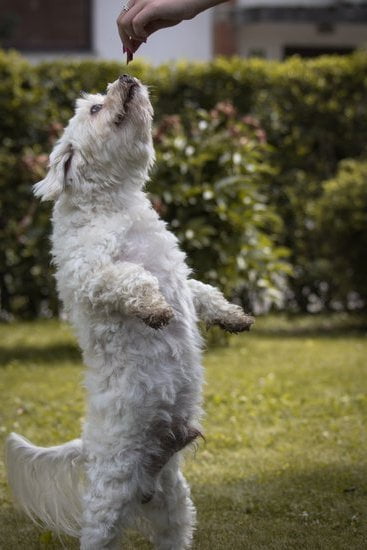Training a dog to free feed can be a convenient and flexible way to ensure your furry friend has access to food throughout the day. Free feeding refers to leaving out food for your dog to eat at their own pace, rather than feeding them at specific meal times. This approach can be beneficial for both you and your pet, promoting self-regulation and reducing anxiety around meal times.
By allowing your dog to free feed, you are giving them the freedom to eat when they are hungry, which can help prevent overeating or begging for food. This method also allows for better weight management and can be particularly useful for dogs with specific dietary needs or medical conditions that require frequent small meals throughout the day.
Understanding the concept of free feeding is the first step towards successfully implementing this feeding method with your dog. In the following sections, we will explore the benefits of free feeding, tips for finding the right dog food, setting up a feeding schedule, training your dog to free feed, monitoring their food intake, troubleshooting common issues, and additional tips for a successful experience.
By following these guidelines, you can create a healthy and enjoyable feeding routine for your beloved canine companion.
Benefits of Free Feeding Your Dog
Free feeding your dog is a feeding method that allows your furry friend to have access to food at all times, rather than scheduled meals. This approach can offer several benefits for both you and your pet, making it a popular choice for many dog owners. By understanding the advantages of free feeding, you can decide if this method is suitable for your dog’s needs.
Promotes Natural Eating Habits
One of the main benefits of free feeding is that it aligns with a dog’s natural eating habits. In the wild, dogs are scavengers and opportunistic feeders, often eating small amounts throughout the day. By allowing your dog to free feed, you mimic this natural behavior and provide them with constant access to food. This can help prevent overeating during mealtimes and reduce the urge to gorge or binge on food.
Reduces Anxiety and Stress
For some dogs, strict meal schedules can be stressful and lead to anxiety around mealtimes. Free feeding eliminates the pressure of designated meal times, allowing your dog to eat when they’re hungry and at their own pace. This can be particularly beneficial for dogs who may have experienced food insecurity or anxiety-related issues in the past. Ultimately, free feeding promotes a more relaxed dining experience for your pet.
Fosters Independence and Self-Regulation
By implementing free feeding, you empower your dog to self-regulate their food intake based on their hunger levels. This helps build independence in your furry companion and encourages them to listen to their body’s cues for nourishment. Through this process, dogs learn to develop healthy eating habits and maintain a balanced diet without relying on fixed meal times. Overall, free feeding encourages dogs to make choices about when and how much they eat based on their individual needs.
Finding the Right Dog Food for Free Feeding
When it comes to free feeding your dog, one of the most crucial decisions you will make is choosing the right dog food. Your furry friend’s diet plays a significant role in their overall health and well-being, so it is essential to select a high-quality option that meets their nutritional needs. Here are some tips for finding the best dog food for free feeding:
Consider Your Dog’s Age, Size, and Breed
One of the first things to consider when choosing dog food for free feeding is your pet’s specific needs based on their age, size, and breed. Puppies, adult dogs, and senior dogs have different nutritional requirements, so make sure to select a formula that is appropriate for your dog’s life stage. Additionally, large breeds may require different nutrients than small breeds, so take these factors into account when making your choice.
Check the Ingredient List
When selecting a dog food for free feeding, it is important to carefully examine the ingredient list. Look for high-quality protein sources such as meat or fish as the first ingredient. Avoid foods that contain fillers like corn or wheat, as these ingredients may not provide optimal nutrition for your dog. Opt for formulas with natural ingredients and limited additives or preservatives for better overall health.
Consult With Your Veterinarian
Before making any changes to your dog’s diet or starting them on a free feeding regimen, it is recommended to consult with your veterinarian. They can provide valuable insight into your dog’s individual nutritional needs and recommend specific brands or formulas that align with those needs. Your vet can also offer guidance on portion sizes and monitor your dog’s weight and health as they transition to free feeding.
By taking these tips into consideration when choosing the right dog food for free feeding, you can ensure that your furry companion receives the proper nutrition they need for a happy and healthy life. Remember that each dog is unique, so it may take some trial and error to find the perfect food that works best for your pet. With careful consideration and attention to detail, you can set your pup up for success with their new free feeding routine.
Setting Up a Feeding Schedule for Free Feeding
Free feeding your dog can be a convenient and flexible way to ensure your furry friend has access to food throughout the day. However, it is essential to establish a feeding schedule to maintain portion control and monitor your dog’s intake. By setting up a routine, you can help regulate your dog’s eating habits and prevent overeating or obesity.
To train your dog to free feed successfully, start by determining the number of meals per day that align with their dietary needs and lifestyle. Some dogs may do well with two meals a day, while others may benefit from three smaller meals spread out. Once you have decided on the frequency of meals, establish set times for feeding to create consistency and predictability for your dog.
It is crucial to monitor the amount of food left in the bowl throughout the day and adjust the portions accordingly based on your dog’s appetite and energy expenditure. Keep track of how much food your dog consumes each day to ensure they are eating a balanced diet and are not under or overfed. Additionally, make sure to provide fresh water at all times to keep your dog hydrated and healthy.
| Feeding Schedule | Recommendation |
|---|---|
| Number of Meals per Day | 2-3 Meals |
| Meal Times | Set Times for Consistency |
| Portion Control | Monitor Food Intake |
| Water Availability | Provide Fresh Water Always |
By establishing a feeding schedule for free feeding, you can promote healthy eating habits in your dog and maintain their overall well-being. Remember that every dog is unique, so it may take some time to find the right routine that works best for your furry companion. With patience and consistency, you can train your dog to free feed successfully while keeping them happy and satisfied with their mealtime experience.
Introducing Free Feeding to Your Dog
When transitioning your dog to free feeding, it is essential to follow a gradual and structured approach to ensure success. Here are some steps to help you introduce this feeding method to your furry friend effectively:
1. Start Slowly: Begin by gradually increasing the amount of food available for your dog throughout the day. This will allow your pet to adjust to the new feeding routine without overeating or experiencing digestive issues.
2. Provide Accessible Food: Ensure that there is always fresh food available for your dog in easily accessible locations around your home. This will encourage self-regulation and prevent food guarding behavior.
3. Monitor Food Intake: Keep an eye on your dog’s eating habits during the transition period. It is important to make sure that your pet is consuming enough food to meet its nutritional needs without overindulging.
By following these steps, you can successfully train your dog to free feed and enjoy the benefits of this feeding method for both you and your furry companion. Remember, patience and consistency are key when implementing any changes in your pet’s routine.
To further assist you in training a dog to free feed, consider using interactive feeding toys or puzzle feeders that will keep them mentally stimulated while eating, promoting a healthy relationship with food and preventing boredom-related behaviors.
Monitoring Your Dog’s Food Intake
When it comes to free feeding your dog, it is essential to keep a close eye on their food intake to ensure they are receiving proper nutrition and maintaining a healthy weight. One way to monitor your dog’s food intake is by using a measuring cup to portion out the daily amount of food recommended for their size and breed.
By keeping track of how much food your dog is eating each day, you can make adjustments as needed to prevent overeating or undereating.
Another important aspect of monitoring your dog’s food intake is paying attention to their body condition. You should regularly check your dog for any signs of weight gain or loss, as well as observing their energy levels and overall health. If you notice any significant changes in your dog’s physical appearance or behavior, it may be necessary to consult with a veterinarian to determine if adjustments need to be made to their feeding routine.
In addition to monitoring your dog’s food intake in terms of quantity, it is also crucial to assess the quality of the food they are consuming. Look for high-quality dog food options that are specifically formulated for their age, size, and activity level.
Read the ingredients list carefully and choose foods that contain real meat as the first ingredient, along with essential nutrients like vitamins, minerals, and antioxidants. Providing your dog with a balanced diet will help ensure they receive the necessary nutrients for optimal health and wellbeing.
| Aspect | Importance |
|---|---|
| Portion Control | Prevents overeating or undereating |
| Body Condition | Indicates if adjustments need to be made |
| Food Quality | Provides essential nutrients for health |
Troubleshooting Common Issues With Free Feeding
Free feeding can be a convenient and stress-free way to ensure your dog has access to food throughout the day. However, some challenges may arise when implementing this feeding method. It is important to address these issues promptly to ensure your dog’s health and well-being. Here are some common problems that may occur with free feeding and how to troubleshoot them:
1. Overeating: One of the main concerns with free feeding is that some dogs may overeat if food is constantly available. This can lead to obesity and other health issues. To prevent this, consider using portion control bowls or automatic feeders that dispense a set amount of food at specific intervals throughout the day.
2. Food Aggression: In multi-pet households, free feeding can sometimes lead to food aggression between pets. If you notice any signs of aggression during meal times, it may be necessary to separate pets during feeding or establish designated feeding areas for each pet.
3. Spoilage: Leaving food out all day can attract pests or cause the food to spoil quickly, especially in warmer climates. To prevent this issue, make sure to use airtight containers for storing dry kibble and clean the feeding area regularly.
By being aware of these potential challenges and taking proactive steps to address them, you can successfully implement free feeding as a feeding method for your dog. Remember that every dog is different, so it may take some trial and error to find the best approach that works for both you and your furry friend.
Additional Tips and Tricks for Successful Free Feeding
Free feeding your dog can be a convenient and stress-free way to ensure they have access to food whenever they need it. However, there are some additional tips and tricks that can help enhance the experience for both you and your furry friend. One important aspect to consider is the type of food you choose to free feed your dog.
Opt for high-quality, nutritious options that meet their dietary needs and preferences. Look for foods made with real meat, whole grains, fruits, and vegetables to provide a well-balanced diet.
In addition to choosing the right food, it’s essential to monitor your dog’s food intake when free feeding. Keep an eye on their weight and body condition to make sure they are maintaining a healthy balance.
If you notice any changes in their eating habits or health, it may be necessary to adjust their feeding schedule or switch to portion-controlled meals instead. Regular vet check-ups can also help ensure your dog is getting the proper nutrition they need.
To make free feeding more engaging for your dog, consider using puzzle toys or interactive feeders that dispense food gradually. This not only provides mental stimulation but also helps slow down their eating pace and prevent overeating. Additionally, incorporating training sessions during meal times can strengthen your bond with your pet and reinforce positive behaviors. With patience, consistency, and these additional tips and tricks, you can successfully train your dog to free feed while keeping them healthy and happy.
Conclusion
In conclusion, training your dog to free feed can be a rewarding experience for both you and your furry companion. By understanding the concept of free feeding, you can provide your dog with the flexibility and autonomy to eat on their own schedule. The benefits of free feeding, including reduced anxiety around mealtimes and better weight management, make it a feeding method worth considering for many pet owners.
When it comes to finding the right dog food for free feeding, it is essential to choose a high-quality option that meets your dog’s nutritional needs. Establishing a feeding schedule and routine is crucial in ensuring that your dog maintains proper nutrition and health while free feeding. Introducing this method to your dog through a step-by-step training process will help them adjust and understand how to approach food in this new way.
As you monitor your dog’s food intake, be sure to address any potential challenges that may arise with free feeding. By troubleshooting common issues and seeking guidance from your veterinarian if needed, you can work towards a successful transition to this feeding method.
Remember to incorporate additional tips and tricks into your free feeding routine to enhance the experience for both you and your four-legged friend. Overall, training your dog to free feed can lead to a happier and healthier bond between you and your pet.
Frequently Asked Questions
Is Free Feeding Good for Dogs?
Free feeding can have both pros and cons for dogs. On the positive side, it allows them to eat when they are hungry, mimicking their natural behavior in the wild.
However, it can lead to obesity if not monitored closely, as some dogs may overeat without regulation. It is important to consider your dog’s individual needs and lifestyle before deciding if free feeding is the right choice.
How Do I Introduce My Dog to Free Feeding?
When introducing your dog to free feeding, it is essential to start gradually. Begin by leaving food out for short periods of time and monitoring your dog’s eating habits.
This will help you determine if they are capable of self-regulating their food intake or if they need a more structured feeding schedule. Slowly increase the amount of time food is available until your dog adjusts to the new feeding routine.
Should Dogs Have Food Available All Day?
Whether or not dogs should have food available all day depends on the individual dog and its specific needs. Some dogs do well with free access to food throughout the day, while others may struggle with self-regulation and overeat.
It is essential to monitor your dog’s weight and overall health closely when considering allowing food availability all day. Consulting with a veterinarian can help you determine what feeding schedule is best for your furry friend.

Welcome to the blog! I am a professional dog trainer and have been working with dogs for many years. In this blog, I will be discussing various topics related to dog training, including tips, tricks, and advice. I hope you find this information helpful and informative. Thanks for reading!





